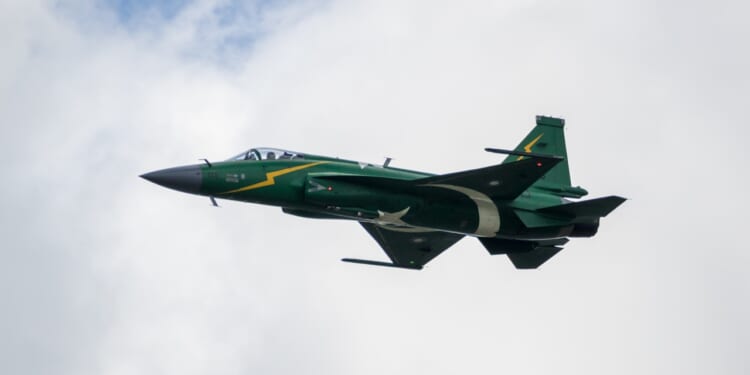Prior to the past days’ clashes, Pakistan most recently displayed the excellence of Chinese warplanes in its aborted war with India in May.
A temporary ceasefire has been declared in the spiraling border war between Pakistan and Taliban-controlled Afghanistan that erupted last week. But the conflict erupted with such a ferocity out of Pakistan that it stunned the Taliban.
Responding to what Islamabad claimed were unacceptable cross-border terrorist attacks by anti-Pakistani insurgents being harbored within Afghanistan, the skilled Pakistani Air Force (PAF) struck hard against Afghanistan—in an apparent attempt to force Kabul into cooperating with Islamabad on anti-terrorism military operations in Afghanistan.
Interestingly, the PAF deployed their Chinese-made warplanes and weapons in their recent wave of airstrikes directed against targets along the Afghanistan-Pakistan border as well as against Kabul itself. China’s JF-17 Thunder was used for cross-border strikes on Taliban hideouts in neighboring Afghanistan. Prior to the past days’ clashes, Pakistan most recently displayed the excellence of Chinese warplanes in its aborted war with India in May.
Pakistan operates the J-10C “Vigorous Dragon” from China, too. Owing to their previous close ties with the United States, the PAF has older F-16s still in service, too.
What to Know About Pakistan’s Chinese-Made Warplanes
The JF-17 was developed as a joint Pakistan-China project under the Pakistan Aeronautical Complex (PAC) and Chengdu Aircraft Corporation (CAC).
Pakistan operates three variants of the JF-17 Thunder. The Block I variant is the barebones version. The Block II possesses improved avionics and can conduct midair refueling. The most advanced variant, the Block III, includes AESA radar, advanced electronic warfare (EW) capabilities, and is believed to have stealth coatings to reduce visibility on enemy radar.
Meanwhile, the J-10C “Vigorous Dragon” was developed by CAC in China. It’s considered a fourth-generation-plus multirole fighter. The J-10C entered service around 2018, with Pakistan acquiring the export version (J-10E) in 2022. These planes were used to great effect against the Indian Air Force (IAF) during the May 2025 war between Pakistan and India.
| Aircraft | JF-17 Thunder | J-10 |
| Year Introduced | 2007 | 2004 |
| Number Built | 177 | 600+ (mostly in China) |
| Length | 14.3 m (47 ft) | 16.9 m (55 ft 5 in) |
| Wingspan | 9.44 m (31 ft) | 9.8 m (32 ft 2 in) |
| Weight (MTOW) | 13,500 kg (17,650 lb) | 19,227 kg (42,388 lb) |
| Engine(s) | One Klimov RD-93MA afterburning turbofan engine (20,500 lbf) | One WS-10B afterburning turbofan engine (20,050 lbf) |
| Top Speed | 1,910 km/h (1,190 mph) | 2,327 km/h (1,446 mph) |
| Combat Radius | 900 km (560 mi); can be extended with drop tanks | 1,240 km (770 mi) |
| Service Ceiling | 16,900 m (55,500 ft) | 18,000 m (59,000 ft) |
| Loadout | One 23mm GSh-23 twin-barrel cannon; 8 hardpoints; 3,400 kg (7,500 lb) payload capacity | One 23mm GSh-23 twin-barrel cannon; 11 hardpoints; 5,600 kg (12,350 lb) payload capacity |
| Aircrew | 1-2, depending on variant | 1 |
The JF-17 forms the mainstay of the PAF fleet, replacing much older Mirage and F-7 aircraft. On the other hand, the J-10C is a high-end fighter that enhances Pakistan’s JF-17 and F-16 fleet, often described as Pakistan’s response to India’s Rafale warplane arsenal.
Whereas the JF-17 is a low-cost, locally maintained multirole fourth-generation warplane designed to ensure self-reliance and fleet size, the J-10C is a more powerful, modern platform meant for air superiority and BVR engagements, enhancing Pakistan’s strategic edge.
Essentially, the Taliban have no idea what hit them. The ceasefire is a blessing for the Taliban; if the Pakistanis chose to keep pressing forward with the air war, which remains a distinct possibility, these weapons would utterly eviscerate them.
About the Author: Brandon J. Weichert
Brandon J. Weichert is a senior national security editor at The National Interest. Recently, Weichert became the host of The National Security Hour on America Outloud News and iHeartRadio, where he discusses national security policy every Wednesday at 8pm Eastern. He is also a contributor at Popular Mechanics and has consulted regularly with various government institutions and private organizations on geopolitical issues. Weichert’s writings have appeared in multiple publications, including The Washington Times, National Review, The American Spectator, MSN, The Asia Times, and others. His books include Winning Space: How America Remains a Superpower, Biohacked: China’s Race to Control Life, and The Shadow War: Iran’s Quest for Supremacy. His newest book, A Disaster of Our Own Making: How the West Lost Ukraine is available for purchase wherever books are sold. He can be followed via Twitter @WeTheBrandon.
Image: Shutterstock / VanderWolf Images.

















